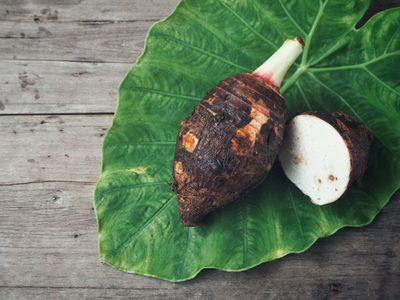Taro, also known as kalo, is a delicious and nutritious edible plant that is an excellent addition to any home garden. Taro can be grown for its starchy corms which are a staple food in many cultures. Additionally, the leaves are edible and full of vitamins and minerals. If you want to try growing your own taro, you first need to find good quality edible taro plants for sale. This guide will cover where to buy taro plants, how to plant and care for them, and harvesting tips to enjoy your own homegrown taro!
Where to Purchase Edible Taro Plants
Taro plants were once difficult to locate for home gardeners but are now more readily available from the following sources:
- Online specialty nurseries – Many innovative nurseries now sell edible plants online and ship across the U.S. Search for key phrases like “edible taro plants for sale” to find ones with good selections.
- Local nurseries – Check with your local independent nurseries to see if they stock taro bulbils or plants. Availability will depend on your climate.
- Ethnic food stores – Visit Asian Hawaiian, or Indian markets to find taro plants sold for growing as well as taro vegetable roots for eating.
- Farmer’s markets – Some small farms or stands at markets may sell taro if they grow it Ask vendors if they have any available,
- Online marketplaces – Sites like Etsy have individual sellers offering taro plants and bulbils for shipment Read reviews carefully when purchasing.
When buying taro for planting, look for plants that appear healthy with no discoloration or damage. For bulbils, choose large, firm ones over smaller pieces.
How to Plant and Grow Taro
Once you’ve sourced good taro plants or bulbils, follow these tips for planting and care:
- Plant in spring – Taro needs warm soil and air temperatures, so plant in spring after the last frost date. Avoid cold weather.
- Water frequently – Keep taro plants consistently moist, watering 1-2 inches per week. Adding mulch helps retain moisture.
- Provide rich soil – Amend planting areas with compost or manure to create nutrient rich, slightly acidic soil.
- Full to partial sun – Taro grows best in 6 hours of direct sun or light shade. More than that can burn the leaves.
- Fertilize monthly – Use a balanced organic fertilizer monthly once plants are established for good growth.
- Weeding – Stay on top of weeds which compete for nutrients. Carefully hand pull weeds around taro plants.
- Pest prevention – Slugs, snails, and aphids may attack taro. Use organic remedies if pests appear.
With optimal care, taro will flourish and be ready for harvest in about 6-12 months depending on variety.
Harvesting and Storing Your Taro
Taro is ready for harvest when the leaves start turning yellow. Here’s how to handle your crop:
- Time it right – Harvest when 7-8 months old for ideal corm size and maturity. Don’t wait too long or the corms will become woody.
- Careful digging – Use a garden fork to gently loosen soil and lift corms without damage. Don’t yank or pull hard.
- Cure corms – Place freshly dug corms in a warm, dry spot to cure for 1-2 weeks before eating. This toughens the skin.
- Cut off tops – Chop off leaf tops leaving 1-2 inches of stem after curing.
- Storage – Cure taro corms can be stored in a cool cellar or fridge for several months.
- Preparation – Taro corms and leaves must be thoroughly cooked before eating to remove irritating oxalates. Boil, bake, or roast.
Growing your own taro is very rewarding and provides a bounty of nutritious food. With the right care, your plants will produce delicious edible corms for many months of harvests. Get started this season with high quality taro plants for sale from reputable sources.

Don’t know what’s TARO PLANTS and edible
FAQ
Which taro plant is edible?
Can you grow taro in the US?
Can you grow taro from grocery store?
What is the best taro plant to eat?
Are taro leaves edible?
Being a perennial herbaceous plant, taro is easily a mainstay in your garden. The edible root varies in size from similar to a softball, to a much larger long root. Taro requires consistently high temperatures, but you can still grow it for the edible leaves if you live in slightly cooler areas. Taro is very high in dietary fiber and carbohydrates.
What is a taro plant?
A highly tropical looking plant grown for its edible tuber, also known as Taro. Large heart-shaped or elephant ear shaped leaves make it a distinctive plant for any garden. Taro, also called the potato of the tropics, is native to the swampy areas in tropical southeastern Asia and has been cultivated for over 6000 years.
What is a good taro plant?
justLeaf. 4 Taro Bulbs: Free 3 Day Shipping from USA. Green Elephant Ear Plants. Colocasia Esculenta, Cocoyam Plant, Fast Growing Edible Vegetable. Contains many Antioxidants and Vitamins EASY TO GROW justLeaf. Giant Taro Bulb: Free 3 Day Shipping from USA. Huge Green Elephant Ear Plants.
- The Ultimate Guide to Growing Strawberries in Raised Beds - August 8, 2025
- No-Dig Garden Beds: The Easiest Way to Grow a Beautiful Garden - August 6, 2025
- How to Protect and Preserve Wood for Raised Garden Beds - August 6, 2025
